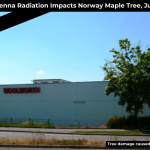LA PORTE, Texas – On a humid summer afternoon in July, about 40 minutes from Houston, children are running up and down the Texas coastline of Sylvan Beach. Families make camps for the day with coolers filled with drinks and snacks.
It doesn’t take more than a few steps near the shore to realize plastics have overtaken the beach. Bottles, bags and wrappers litter the sand with no trash cans in sight. Intermingled with the sand, small white disks begin to appear beneath your feet. At first glance, you may assume they are shells, many of the local birds do too. But they are hard plastic pellets, or nurdles.
To read and watch a version of this story in Spanish click here. Haz clic aquí para leer este reportaje en español.
These nurdles — which can absorb harmful toxics and pollute the environment as they continue to degrade into smaller microplastics – are produced by more than 140 facilities across the U.S., including 36 in Texas. Most of them are clustered, mirroring the oil, gas and petrochemical plants along the coast, according to a new mapping initiative from the non-profits Environment America and Public Interest Research Group. The new report gives insight into where the unregulated nurdles, and other pre-production plastics such as flakes, beads and powders, are coming from.
“Plastic pellets may be tiny, but they pose a huge threat to wildlife,” Environment Texas Executive Director, Luke Metzger, said. “Turtles, birds and fish need waterways free from microplastic pollution, but if they live near one of these plastic-producing plants, they could be at risk. That’s why we’re calling on lawmakers to stop facilities from dumping or spilling pellets into our waterways.”
Using federal data from the U.S. Environmental Protection Agency’s Toxic Release Inventory, or TRI, Environment America compiled a list of 141 U.S. facilities that create pre-production plastic, which often consists of nurdles usually no larger than a grain of rice. Familiar plastics, like bottles and containers, are created by melting and molding these tiny building blocks. Even before becoming a usable item, these microplastics can contribute to the plastic pollution crisis, as they are not regulated as pollution in the U.S.
Nearly a quarter of producing facilities — 36 in total — dot Texas’ coastline, in a similar pattern to the state’s countless oil and gas facilities. This is not coincidental, as petrochemicals are integral to plastics production. Of the 36 facilities, 19 have violated environmental regulations in the past year, according to their online EPA enforcement and compliance histories. Nine of these 19 have significant violations of environmental regulations for at least 12 quarters, or 3 years. Compliance data for three facilities was not available.
“The pollution generated to turn petrochemicals into these microplastic pellets is damaging many communities and this map highlights that the harm doesn’t stop there,” Matt Smelser, deputy communications director of Beyond Petrochemicals, told EHN.
Nurdle Hunt, a project of the environmental charity Fidra, estimates nearly 491 thousand tons of nurdles enter the environment each year around the globe. According to a report by Pew Charitable Trusts, a non-profit that specializes in investigative data analysis, nearly half of these tons, or more than 242,000, enter the ocean and 18% of all microplastics in the ocean is from pellet pollution.
It’s hard to put concrete numbers on the impacts of pellet pollution on a local scale. There’s little standardized data conducted on nurdles in general and even less for specific beaches or coastlines. Jace Tunnell, the lead scientist of the citizen science project Nurdle Patrol Project, which aims to raise awareness about nurdle pollution along the Gulf Coast, has used the data from 10-minute clean up events to estimate amounts of nurdle pollution per kilometer and provided the data to the Texas Commission on Environmental Quality. At just one beach, his estimates were as high as 1 million nurdles per kilometer.
While the Pew Charitable Trusts report notes that as plastic production increases pellet pollution might get worse, it is “highly feasible” to reduce this type of pollution by regulating nurdles’ creation, transportation and disposal.
A first step, experts agree, would be to regulate plastic pellets, as they are virtually unregulated in the U.S. and much of the world. In the past, the EPA has tried to address plastic pellet pollution in California invoking the Clean Water Act, limiting how much pellet pollution enters waterways. However, there are no federally recognized regulations or amendments to the act that explicitly mention plastic pellets and the EPA’s regulatory authority over nurdles has been called into question and remains uncodified. The Texas Commission on Environmental Quality planned to regulate nurdles back in 2022, but ultimately retreated.
“Plastic pellet pollution has become ubiquitous in too many of our communities,” PIRG’s Beyond Plastic Advocate Kelly Leviker said in a press release. “I’m hoping this resource will help folks learn more about plastic manufacturing and potential pollution sources within their community.”




